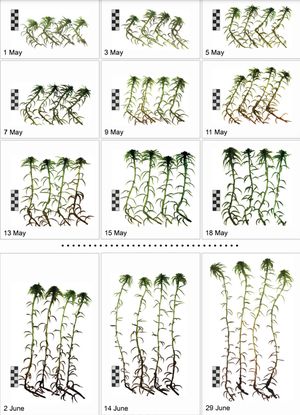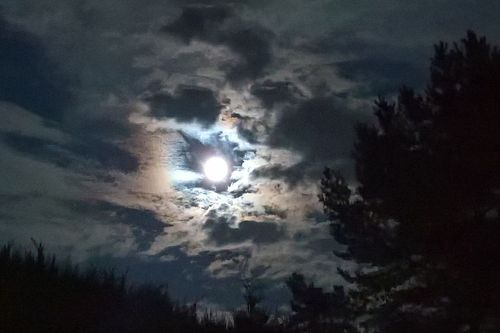Peat mosses (Sphagna) are a convenient object for research. Some members of this genus, such as Sphagnum riparium, grow fast and form a smooth carpet. This enables detailed observations of the moss growth in natural habitats. Viktor Mironov has been conducting such observations since 2015. Every year from April through November, the scientist goes to the bog to measure increment in 300–500 moss shoots. His archives contain data on 185 000 shoots for which 8350 growth rate estimates have been made.
Doing his research, the scientist noted that Sphagnum growth rates fluctuate rhythmically, with roughly 30-day cycles, corresponding to the lunar cycle. Science, however, had not yet provided a clear explanation of how exactly the lunar cycle induced such growth fluctuations in plants.
– The effect of the lunar cycle on living organisms has been poorly investigated. Current studies find it in a wide range of organisms, including plants. Some researchers attribute it to gravity, while others consider geomagnetic field perturbations, atmospheric electricity tides, moonlight fluctuations, etc. as options. The explanation that appears the most convincing is the effect of the Moon through light variations. This hypothesis has been substantiated for animals, who can see changes in moonlight directly, but such data for plants were missing, — told the researcher.

All these measurements have permitted Viktor Mironov to check the “light-mediation” hypothesis of the lunar cycle effect. Information of crucial importance was lower cloudiness data from the local weather station. The clouds occupy altitudes of up to 2 km, appear as gray heterogeneous ridges and rolls, often forming a solid cover blocking off much of the solar and lunar light. The scientist supposed that if the lunar cycle actually influenced plants via light, then the effect should be attenuated by heavier cloudiness and vice versa.
– The results show that when cloudiness is below 40%, the effect of the lunar cycle on Sphagnum growth is the strongest, but starting with 40% up it progressively grows weaker. At 60% cloudiness the effect falls to the significance level and then tends to zero at greater cloudiness levels. This tendency was verified for waning and waxing Moon separately, and the result was the same in both cases. Thus, the results prove convincingly that Sphagna perceive the lunar cycle via fluctuations in light levels. This mechanism can be projected onto other members of the plant kingdom, — informed the author of the study.

Notably, moonlight has an inhibiting effect on shoot growth. Research has shown that Sphagnum growth rates decline around full moons, when moonlight is the brightest, and are accelerated around new moons, when moonlight is near absent. As opposed to sunshine, whose major function for plants is to provide energy, the milder moonlight apparently has the information role. Captured by the plants’ sensitive receptors, it serves as a signal for the systems that regulate the growth rate.
The researcher plans to elucidate how various ecological factors influence plants during one or another phase of the lunar cycle. This information can potentially be useful for upgrading agricultural practices and promoting crop productivity.
Previously, this scientist has designed and patented a technique for using plants to detect the shortest solar ultraviolet B waves (UV-B), which are hard to record by physical instruments.
Photos from pixabay.com and from Viktor Mironov’s archive






